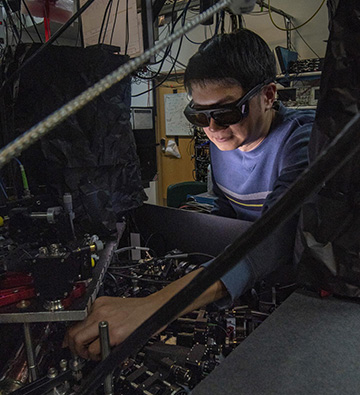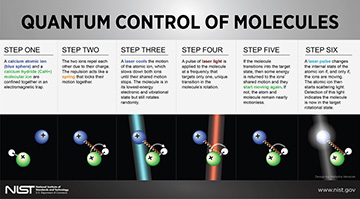
NIST physicist James Chin-wen Chou in the laser lab. Chou led a team that used quantum-logic spectroscopy (QLS) to achieve quantum entanglement between an atom and a molecule, which could enable the use of molecules as connecting links in hybrid quantum information systems. [Image: Burrus/NIST]
Recent years have seen amazing advances in the control of ensembles of trapped neutral atoms and of atomic ions, both of which are key candidates to serve as information carriers in quantum computers. In many ways, molecules offer a far richer palette of quantum states and frequencies to access in such applications. That promise has pushed significant strides in techniques to initialize, detect and read out molecular quantum states.
Building on one strand of this work, researchers at the U.S. National Institute of Standards and Technology (NIST) have now moved the needle further, demonstrating the entanglement of an atomic ion with multiple quantum states of a trapped molecular ion (Nature, doi:10.1038/s41586-020-2257-1). The work, the researchers suggest, could open up a broader array of properties to exploit in the quantum bits (qubits) of quantum computers. It even raises the prospect of multi-platform quantum computing, with molecules acting as a sort of bridge connecting other quantum systems.
Molecular attractions
Molecules constitute an attractive quantum vehicle because their very complexity offers additional degrees of freedom for researchers to play with. These include not only internal energy-level transitions, but also vibrational and rotational modes absent from single atoms. That means that a single molecule could, in principle, deliver qubit information at a variety of characteristic frequencies—ranging from a few kHz for some energy-level transitions, to GHz for hyperfine transitions, to THz for rotational transitions, to hundreds of THz for vibrational transitions.
That range of frequencies raises tantalizing prospects for well-controlled molecules in a variety of quantum systems. One particularly intriguing avenue would be the use of molecules as a sort of multi-frequency antenna or bridge coupling different quantum systems operating at different frequencies. That, in turn, points to the possibility of putting molecules into service as the glue that ties together different kinds of quantum bits—such as those involving atoms, superconducting circuits and telecom-wavelength photons—into larger-scale, mixed-platform computers or networks.
QLS: Manipulating a molecule with an atom
Bringing these ideas closer to reality requires demonstrating the ability to achieve entanglement between the quantum states of a molecule and of another qubit, to create a coupled system for mining the molecule’s quantum information. In an entangled state, the quantum properties of two qubits are intimately connected, such that measurement of one particle affects the quantum state of the other.
In 2017, the NIST team showed how quantum-logic spectroscopy (QLS) could use an atomic ion to probe the quantum state of a nearby trapped molecular ion, as shown in this information graphic. Now, the team has extended the system, using QLS to achieve actual quantum entanglement between the two particles. [Image: N. Hanacek/NIST] [Enlarge image]
The NIST researchers, led by James Chin-wen Chou, sought to demonstrate such entanglement between a molecule and an atom—by building on some of the lab’s previous work. In a study published in 2017, Chou’s team used a technique called quantum-logic spectroscopy (QLS) to prepare, manipulate and read out quantum states from a single molecule. In QLS, an atomic ion, vibrationally connected to a molecular ion in a magnetic trap and addressed by various laser beams, is used as an indirect, non-destructive probe of the molecule’s quantum states.
Entanglement experiment
Three years later, Chou’s team has now pushed the system to the next milestone. The team has not just used an atomic ion to probe the state of a molecular one, but has shown how QLS can set up actual quantum entanglement between the states of the two particles.
The approach begins with the capturing of a 40Ca+ atomic ion and a 40CaH+ molecular ion in a linear Paul trap. The tight confinement of the two positively charged particles, and their consequent Coulomb repulsion, sets up a vibrational bond between them. Lasers that are resonant with the transitions of the calcium ion are then used to sympathetically cool the coupled vibrational modes of the confined two-ion “crystal.”
The next step is to nudge the trapped molecular ion into a specific quantum state (or, more precisely, a superposition of several states) to be entangled with the coupled atomic ion. To do that, the team uses pair of laser sources—a 1051-nm fiber laser and an optical frequency comb source centered at 850 nm—to drive two-photon stimulated Raman transitions in the trapped molecule. Those transitions create a molecular qubit consisting of a superposition a low-frequency (13.4 kHz) and high-frequency (855 GHz) rotational state. These states, in turn, are transferred via an out-of-phase vibrational mode between the trapped molecule and the trapped ion.
Finally, pulses from a 729-nm laser tickle the trapped atomic ion into a quantum superposition of its own electronic ground state and an excited state with a lifetime of roughly one second. By carefully tuning the sequence laser pulses, the team is able to boost the probability of entanglement between this atomic state and the molecular state. To test whether that entanglement is realized, the team first uses fluorescence measurement to determine the state of atomic ion; then, in a QLS measurement, the ion itself is used to assess the state of the molecule.
High entanglement fidelity
The NIST researchers found that, using this setup, they could achieve an entanglement fidelity of 0.87 (essentially, entanglement 87% of the time) between the atom and the lower-frequency, 13.4-kHz rotational mode, and a fidelity of 0.76 with the higher-frequency, 855-GHz mode. Particularly significant, in the team’s view, is that both modes were being entangled with an atomic state at yet another characteristic transition frequency, 411 THz. That, according to the study, establishes the potential value of molecules “for quantum state transduction between qubits of very different frequencies.”
This ability of molecules to mediate between different kinds of qubits could, in the team’s view, allow them to be used as a component for linking up different kinds of quantum hardware, enabling hybrid quantum systems. That’s a particularly interesting prospect, the team adds, because the same technique, applied to different species of molecules, could give access to transitions at still other frequencies.
“Molecules provide a selection of transition frequencies and we can choose from many types of molecules,” the team leader, Chou, said in a press release accompanying the work. “So that is a huge range of qubit frequencies we can bring into quantum information science.”

